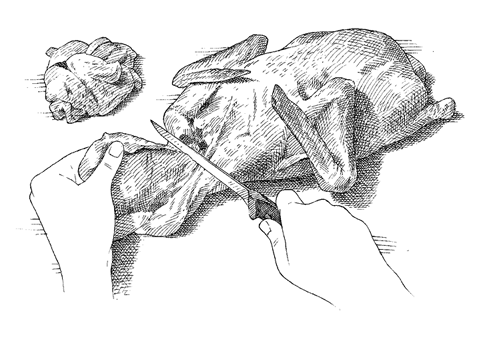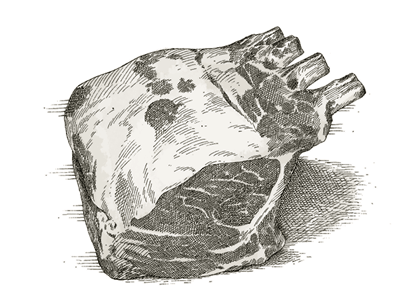The Cook's Illustrated Cookbook (170 page)
Read The Cook's Illustrated Cookbook Online
Authors: The Editors at America's Test Kitchen
Tags: #Cooking


Trim away skin that is not directly over meat or bone. Pull back skin in neck cavity and cut away pieces of fat to expose wing joints.

![]() WHY THIS RECIPE WORKS
WHY THIS RECIPE WORKS
For the best pan-seared steak, we used smaller, more expensive cuts like rib eye, boneless strip, and sirloin, which browned evenly and had a full, rich flavor. As for our pan-searing technique, we started with a very hot pan that would sear the steak upon contact. We found it best to heat the oil in the pan over medium-high heat and then retain this heat level throughout cooking. The oil also helped to brown the steak and keep it from sticking to the pan.
SERVES 4
Serve the steaks as is or with a flavored butter or sauce (recipes follow).
1 | tablespoon vegetable oil |
4 | (8- to 10-ounce) boneless strip steaks or rib-eye steaks, |
Salt and pepper | |
1 | recipe butter or pan sauce (optional) (recipes follow) |
1.
Heat oil in 12-inch skillet over medium-high heat until just smoking. Meanwhile, pat steaks dry with paper towels and season both sides with salt and pepper.
2.
Lay steaks in pan, leaving ¹⁄
4
inch between them. Cook, without moving steaks, until well browned, about 4 minutes. Using tongs, flip steaks and continue to cook until meat registers 115 to 120 degrees (for rare) or 120 to 125 degrees (for medium-rare), 3 to 7 minutes. Transfer steaks to serving platter and tent loosely with aluminum foil to rest or while preparing butter or pan sauce, if using, then serve.
MAKES ABOUT
¹⁄
4
CUP, ENOUGH FOR 1 RECIPE
SIMPLE PAN-SEARED STEAKS
Mash together 2 tablespoons room-temperature butter, ¹⁄
4
cup crumbled Roquefort cheese, and ¹⁄
2
teaspoon brandy. Season with salt and pepper to taste. Top each cooked steak with portion of flavored butter and serve.
MAKES ABOUT
¹⁄
2
CUP, ENOUGH FOR 1 RECIPE
SIMPLE PAN-SEARED STEAKS
Stir together ¹⁄
4
cup each sour cream and prepared horseradish. Season with salt and pepper to taste and serve alongside each cooked steak.
MAKES ABOUT 1 CUP, ENOUGH FOR 1 RECIPE
SIMPLE PAN-SEARED STEAKS
Wipe fat from skillet; add 1¹⁄
2
cups chicken broth, then boil until reduced by one-half. Stir in 3 tablespoons Dijon mustard, 2 tablespoons butter, and salt and pepper to taste; spoon portion of sauce over each cooked steak.
A MORE AFFORDABLE DRY-AGED STEAK
In commercial dry-aging, butchers hold large primal cuts of beef (typically the rib or short loin sections) for up to 30 days in humid refrigerators ranging between 32 and 40 degrees. The humidity is necessary to prevent the meat’s exterior from drying out too much. As moisture evaporates, the fat becomes more concentrated, increasing meaty flavor. The dehydration process also triggers the breakdown of muscle proteins, resulting in a dense, more tender texture. At the same time, the breakdown of muscle encourages the formation of amino acids and peptides, which impart a meatier, smokier taste.
To try replicating these results at home, we bought rib-eye and strip steaks (each $10.99 per pound) and stored them in the back of the refrigerator, where the temperature is coldest. Since home refrigerators are less humid than commercial dry-aging units, we wrapped the steaks in cheesecloth to allow air to pass through while preventing excess dehydration. We checked them after four days (the longest length of time we felt comfortable storing raw beef in a home fridge).
Next, we pan-seared the home-aged steaks and tasted them alongside a batch of the same commercially dry-aged cuts costing $19.99 per pound. Sure enough, our “home” dry-aged steaks boasted a comparably smoky flavor and dense, tender texture. So, save yourself a few bucks, but remember to wrap the meat in plenty of cheesecloth, place it on a wire rack for air circulation, and store it in the coldest part of the fridge.
![]() WHY THIS RECIPE WORKS
WHY THIS RECIPE WORKS
We love the ultra-rich flavor and glossy consistency that a classic French demi-glace (a savory, full-bodied reduction traditionally made from veal bones and stock) adds to a sauce, but making it is a time-consuming process usually left to the expertise of professional cooks. We wanted to find a shortcut for making demi-glace at home, so that we could use it as the base of a sauce for crusty, pan-seared steaks. Chopping up vegetables (to increase their surface area, thus providing more opportunity for flavorful browning) as well as adding mushrooms, tomato paste, and seasonings to red wine and beef broth was a good start, but it wasn’t enough. To replicate the meaty flavor and unctuous gelatin given up by roasted bones, we sautéed ground beef with the tomato paste and stirred powdered gelatin into the final reduction.
SERVES 4
We like this sauce with strip or rib-eye steaks, but it will work with any type of pan-seared steak.
1 | recipe |
1 | small shallot, minced |
¹⁄ | cup white wine |
¹⁄ | cup |
¹⁄ | teaspoon white wine vinegar |
1¹⁄ | teaspoons minced fresh chives |
1¹⁄ | teaspoons minced fresh parsley |
1 | teaspoon minced fresh tarragon |
1 | tablespoon unsalted butter |
Salt and pepper |
After transferring steaks to platter to rest, return now-empty skillet to medium-low heat; add shallot and cook, stirring constantly, until lightly browned, about 2 minutes. Add wine and bring to simmer, scraping bottom of skillet with wooden spoon to loosen any browned bits. Add Sauce Base, vinegar, and any accumulated juices from steak; return to simmer and cook until slightly reduced, about 1 minute. Off heat, whisk in chives, parsley, tarragon, and butter; season with salt and pepper to taste. Spoon sauce over steaks and serve.
Substitute brandy for white wine and red wine vinegar for white wine vinegar. Omit chives, parsley, tarragon, and butter. Add ¹⁄
4
cup heavy cream, 2 tablespoons rinsed whole green peppercorns, and ¹⁄
4
teaspoon chopped fresh thyme to skillet along with Sauce Base and vinegar.
Substitute ruby port for white wine and balsamic vinegar for white wine vinegar. Substitute ¹⁄
4
teaspoon chopped fresh thyme for chives, parsley, and tarragon.
MAKES
¹⁄
2
CUP
The sauce base recipe yields more than called for in the steak recipe; leftovers can be refrigerated for up to 3 days or frozen for up to 1 month.
1 | small onion, peeled and cut into rough ¹⁄ |
1 | small carrot, peeled and cut into rough ¹⁄ |
8 | ounces cremini mushrooms, trimmed and halved |
2 | garlic cloves, peeled |
1 | tablespoon vegetable oil |
8 | ounces 85 percent lean ground beef |
1 | tablespoon tomato paste |
2 | cups dry red wine |
4 | cups beef broth |
4 | sprigs fresh thyme |
2 | bay leaves |
2 | teaspoons whole black peppercorns |
5 | teaspoons unflavored gelatin |
1.
Pulse onion, carrot, mushrooms, and garlic in food processor into ¹⁄
8
-inch pieces, 10 to 12 pulses, scraping down bowl as needed.
2.
Heat oil in Dutch oven over medium-high heat until shimmering; add beef and tomato paste and cook, stirring frequently, until beef is well browned, 8 to 10 minutes. Add vegetable mixture and cook, stirring occasionally, until any exuded moisture has evaporated, about 8 minutes. Add wine and bring to simmer, scraping bottom of pot with wooden spoon to loosen any browned bits. Add broth, thyme, bay leaves, and peppercorns; bring to boil. Reduce heat and gently boil, occasionally scraping bottom and sides of pot and skimming fat from surface, until reduced to 2 cups, 20 to 25 minutes.
3.
Strain mixture through fine-mesh strainer set over small saucepan, pressing on solids with rubber spatula to extract as much liquid as possible (you should have about 1 cup stock). Sprinkle gelatin over sauce base and stir to dissolve. Place saucepan over medium-high heat and bring sauce base to boil. Gently boil, stirring occasionally, until reduced to ¹⁄
2
cup, 5 to 7 minutes. Remove from heat and cover to keep warm.
